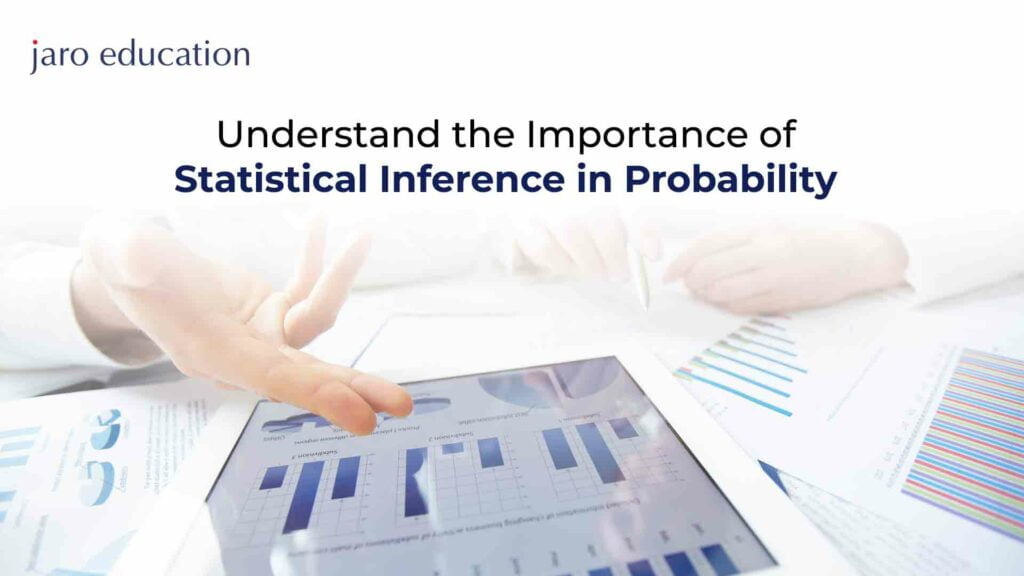Probability is a mathematical concept that deals with the likelihood or chance of an event occurring. It provides a measure of the uncertainty associated with random events, such as the outcome of a coin toss or the roll of a die.
Statistical inference, on the other hand, is the process of using data to make inferences about a population based on a sample of that population. It is a way to use the data to learn about the underlying population and make predictions or draw conclusions about it.
The role of statistical inference in probability is to use the sample data to make generalisations about the population. It provides a way to make predictions and draw conclusions about a population based on limited information, which is often the case in real-world problems. Through statistical inference, we can make predictions about future events and evaluate the accuracy of our models and hypotheses. Additionally, it allows us to make decisions based on data, such as deciding the best treatment for a patient based on their medical history.
Basic Concepts of Probability
Sample Space and Events:
A sample space is the set of all possible outcomes for a random event. An event is a subset of the sample space representing a particular outcome or set of outcomes. The probability of an event is the measure of the likelihood of that event occurring.
Probability Distribution:
A probability distribution is a function that describes the likelihood of each possible outcome in a sample space. There are different types of probability distributions, including discrete distributions, such as the Bernoulli and Binomial distributions, and continuous distributions, such as the Normal and Exponential distributions.
Measures of Central Tendency:
Measures of central tendency are used to summarise a set of data by finding its central value. The most commonly used measures of central tendency are the mean, median, and mode. The mean is the average of all the values in the data set, while the median is the middle value when the data is sorted. The mode is the value that occurs most frequently in the data set.
Measures of Dispersion:
Measures of dispersion describe the spread or variability of a set of data. The most commonly used measures of dispersion are range, variance, and standard deviation. The range is the difference between the largest and smallest values in the data set, while the variance and standard deviation measure how much the data deviates from the mean. A small variance and standard deviation indicate that the data is clustered around the mean, while a large variance and standard deviation indicate that the data is spread out.
The Purpose of Statistical Inference:
Estimating Population Parameters:
The primary purpose of statistical inference is to estimate population parameters based on sample data. Population parameters, such as the mean and standard deviation, describe the characteristics of an entire population. By using sample data, statistical inference provides a way to estimate these parameters and make generalisations about the population.
Hypothesis Testing:
Hypothesis testing is a process of testing a claim or assumption about a population based on sample data. The hypothesis testing aims to determine if the sample data supports or rejects the claim. For example, hypothesis testing can be used to determine if there is a difference between two population means or if a new treatment is effective.
Model Selection:
Model selection is the process of selecting the best statistical model to represent the relationship between variables in a data set. This involves choosing the model that best fits the data and provides the most accurate predictions. Model selection is an important step in statistical inference as it allows us to make informed decisions based on data.
Making Decisions Based on Data:
Statistical inference provides a basis for making decisions based on data. For example, it can be used to determine the most effective treatment for a patient based on their medical history or to select the best marketing strategy based on customer data.
Methods of Statistical Inference:
Point Estimation:
Point estimation is the process of finding the most likely value for a population parameter based on sample data. Point estimates provide a single value representing the population parameter estimate. For example, the sample mean is a point estimate of the population mean.
Confidence Intervals:
Confidence intervals are a range of values that are believed to contain the true value of a population parameter with a certain level of confidence. Confidence intervals provide a way to measure the uncertainty associated with point estimates and provide a range of plausible values for the population parameter.
Hypothesis Testing:
Hypothesis testing is a statistical method used to test a claim or assumption about a population based on sample data. It involves formulating a null and alternative hypothesis, collecting sample data, and deciding based on the data and a pre-determined significance level.
Maximum Likelihood Estimation:
Maximum likelihood estimation is a method of finding the parameters of a statistical model that maximise the likelihood of observing the sample data. It is a common method used in statistical inference as it provides a way to estimate population parameters that are most consistent with the sample data.
Bayesian Inference:
Bayesian inference is a statistical method incorporating prior knowledge and beliefs into data analysis. It provides a way to update beliefs and make predictions based on new data. Bayesian inference is used in a variety of applications, including predictive modelling and hypothesis testing.
Applications of Statistical Inference:
Survey Sampling
Survey sampling is the process of selecting a subset of individuals from a population to participate in a survey. Statistical inference is used to make generalisations about the population based on the responses from the sample. This allows researchers to make estimates about the opinions, attitudes, and behaviours of a large population based on data from a smaller sample.
Medical Trials:
Medical trials use statistical inference to determine the effectiveness of new treatments or medications. Statistical inference provides a way to determine the statistical significance of treatment effects and estimate treatments’ effectiveness in the population. The results of medical trials are used to make decisions about the use of treatments in clinical practice.
Quality Control:
Quality control uses statistical inference to ensure that products meet certain standards. Statistical inference provides a way to make decisions about the quality of products and to take corrective action if necessary. For example, statistical methods can be used to monitor the production process and to detect any deviations from the desired standards.
Predictive Modeling:
Predictive modelling uses statistical inference to make predictions about future outcomes based on past data. Predictive models can be used in a variety of applications, including financial forecasting, customer behaviour analysis, and market research.
Challenges and Limitations of Statistical Inference:
Bias and Variance Trade-off:
Bias and variance are two important considerations in statistical inference. Bias refers to the difference between a population parameter’s estimated value and the true value. Variance refers to the amount of variation in the population parameter estimates. The goal of statistical inference is to find a balance between bias and variance to ensure that the estimates are both accurate and reliable.
Overfitting and Underfitting:
Overfitting and underfitting are two common challenges in statistical modeling. Overfitting occurs when a model is too complex and fits the data too well, leading to poor predictions for new data. Underfitting occurs when a model is too simple and does not fit the data well, leading to poor predictions for both the training data and new data.
Multiple Comparisons:
Multiple comparisons are a common challenge in hypothesis testing. The likelihood of making a false positive increases when multiple tests are performed. Statistical methods, such as the Bonferroni correction, can be used to control the false positive rate in multiple comparisons.
Sampling Issues:
Sampling issues are a common challenge in statistical inference. Sampling bias can occur when the sample is representative of the population, leading to accurate estimates of population parameters. Other issues, such as non-response and measurement error, can also affect the quality of the sample data and the validity of the statistical inferences.
In conclusion, statistical inference plays a crucial role in the field of probability and data science. It provides a way to make generalisations about populations based on sample data and make decisions based on data. The advanced professional certification programme in data science and machine learning offered by E&ICT, IIT Guwahati, emphasises the importance of statistical inference in real-world problems and provides an opportunity for individuals to improve their statistical skills through a data science certification course. The need for continuous improvement in statistical methods is a key aspect of the programme, as statistical inference is constantly evolving and improving in response to new challenges and developments in the field of data science.





